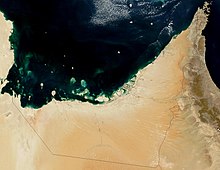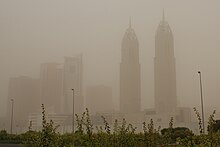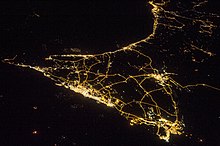
The United Arab Emirates is situated in the Middle East and West Asia, bordering the Gulf of Oman and the Persian Gulf, between Oman and Saudi Arabia; it is at a strategic location along the northern approaches to the Strait of Hormuz, a vital transit point for world crude oil. The UAE lies between 22°50′ and 26° north latitude and between 51° and 56°25′ east longitude. It shares a 19 km (12 mi) border with Qatar on the northwest, a 530 km (330 mi) border with Saudi Arabia on the west, south, and southeast, and a 450 km (280 mi) border with Oman on the southeast and northeast.

The United Arab Emirates is a high-income developing market economy. The UAE's economy is the 3rd largest in the Middle East, with a gross domestic product (GDP) of US$415 billion in 2021-2023.

The United Arab Emirates (UAE), or simply the Emirates, is a country in West Asia, in the Middle East. It is located at the eastern end of the Arabian Peninsula and shares borders with Oman and Saudi Arabia, while also having maritime borders in the Persian Gulf with Qatar and Iran. Abu Dhabi is the country's capital, while Dubai, the most populous city, is an international hub.
Ahmed Ali Al Sayegh is an Emirati politician who is a minister of state in the United Arab Emirates since 19 September 2018.

Masdar (Arabic:مصدر), also known as the Abu Dhabi Future Energy Company, is an Emirati state-owned renewable energy company. It was founded and chaired by Sultan Al Jaber in 2006 as a subsidiary of Mubadala Investment Company. The company is responsible for development of Masdar City, which is the headquarters of International Renewable Energy Agency.

The Abu Dhabi National Oil Company, known by its acronym ADNOC, is the state-owned oil company of the United Arab Emirates (UAE).

Dolphin Energy is a gas company of Abu Dhabi, United Arab Emirates. It was established in March 1999 by the Government of Abu Dhabi. As of today, Dolphin Energy is owned by Mubadala Investment Company, on behalf of the Government of Abu Dhabi,, Total S.A. (24.5%) and Occidental Petroleum (24.5%). It also has operations based in Doha, Qatar.

Abu Dhabi is the capital of the United Arab Emirates. The city of Abu Dhabi is the capital of the Emirate of Abu Dhabi and the UAE's second-most populous city after Dubai.
The Abu Dhabi National Energy Company, PJSC (TAQA) is a government controlled energy holding company of Abu Dhabi, United Arab Emirates.

The water-energy nexus is the relationship between the water used for energy production, including both electricity and sources of fuel such as oil and natural gas, and the energy consumed to extract, purify, deliver, heat/cool, treat and dispose of water sometimes referred to as the energy intensity (EI). Energy is needed in every stage of the water cycle from producing, moving, treating and heating water to collecting and treating wastewater. The relationship is not truly a closed loop as the water used for energy production need not be the same water that is processed using that energy, but all forms of energy production require some input of water making the relationship inextricable.
The three cities of Abu Dhabi Emirate within the United Arab Emirates – the coastal city Abu Dhabi itself as well as the inland oases Al Ain and Liwa – receive their drinking water supply entirely from desalinated seawater.
Energy in the United Arab Emirates describes energy and electricity production, consumption and import in the United Arab Emirates (UAE). The UAE has 7% of global proved oil reserves, about 100 billion barrels. Primary energy usage in 2009 in the UAE was 693 TWh and 151 TWh per million persons.

Sultan Ahmed Al Jaber, is an Emirati politician who is the minister of industry and advanced technology of the United Arab Emirates, head of the Abu Dhabi National Oil Company (ADNOC), and chairman of Masdar.
Dubai is a city in the United Arab Emirates and is recognized as one of the fastest-growing cities in the world. This rapid urbanization has led to many environmental issues, because of the harsh environment, paucity of local resources such as food, water, and building materials, and the unplanned manner of expansion.

While being a major oil producing country, the United Arab Emirates (UAE) has taken steps to introduce solar power on a large scale. However, solar power still accounts for a small share of energy production in the country. The country was the 6th top carbon dioxide emitter per capita in the world in 2009, with 40.31 tonnes, but is planning to generate half of its electrical energy by 2050 from solar and nuclear sources, targeting 44% renewables, 38% gas, 12% coal, and 6% nuclear energy sources.
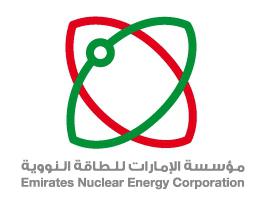
The Emirates Nuclear Energy Corporation is the entity responsible for the deployment and ownership of nuclear energy plants in the United Arab Emirates (UAE).
The desert-covered Kingdom of Saudi Arabia is the geographically largest country in the Middle East. Moreover, it accounts for 65% of the overall population of the GCC countries and 42% of its GDP. Saudi Arabia does not have a strong history in environmentalism. Thus, as the number of population increases and the industrial activity grows, environmental issues pose a real challenge to the country.
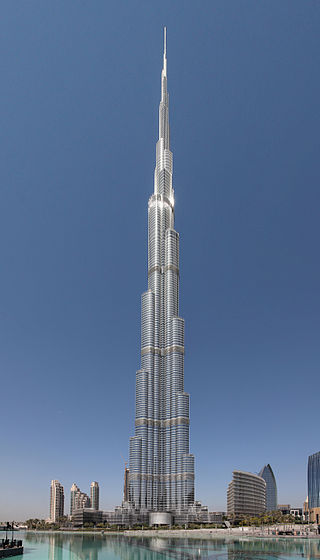
The architecture of the United Arab Emirates has undergone dramatic transformation in recent decades, from operating as a collection of fishing villages to a global business hub known for its innovation and dynamism. Between the 1960s and 1970s, architecture in the United Arab Emirates (UAE) remained solely traditional, with narrow alleys and windtower houses still in use, reflective of a strong Bedouin heritage. Architecture is influenced by elements of Islamic, Arabian and Persian culture.

Climate change in the Middle East and North Africa (MENA) refers to changes in the climate of the MENA region and the subsequent response, adaption and mitigation strategies of countries in the region. In 2018, the MENA region emitted 3.2 billion tonnes of carbon dioxide and produced 8.7% of global greenhouse gas emissions (GHG) despite making up only 6% of the global population. These emissions are mostly from the energy sector, an integral component of many Middle Eastern and North African economies due to the extensive oil and natural gas reserves that are found within the region. The region of Middle East is one of the most vulnerable to climate change. The impacts include increase in drought conditions, aridity, heatwaves and sea level rise.

The Jebel Ali Power and Desalination Plant is a gas- and oil-powered CCGT plant combined with a desalination plant southwest of Dubai in the United Arab Emirates.
